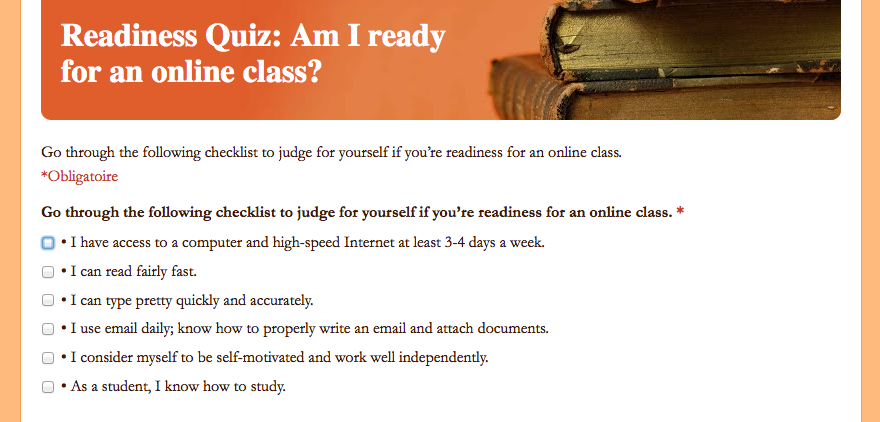From our textbook, this week we had to read: Ko & Rossen, Chapter 10: Preparing Students for Online Learning.
In these pages, various challenges are discussed such as problems that students typically encounter in an online class. I can relate a lot to this as one of my Master degrees was completed entirely online. The terminology can definitely be a challenge for students who aren’t familiar with the “online world” let alone taking a class online. Technical Problems also exist either because a) the browser they are using is too old or b) because they haven’t installed the necessary plug-ins. Students can also get frustrated if they aren’t able to share documents. I’ve seen this issue in my own “blended” class. As instructors, we must, consequently, provide them with the necessary tools to navigate through the online class and best learn. To do this, we can offer student orientations. I have created various tutorials (or screen-shot videos) that explains “where is what” on Blackboard. Those short videos seem to be very useful for students to understand the terminology and placement of various items of the course. I’ve created a short one-minute video of myself, introducing myself as their instructor. Hopefully that will make the online aspect of the class more personable. Also, telling students when we are available is important. They need to know they are not alone in this.
In my on-campus class, I ask students to introduce themselves (in the target language) both in class and on the Discussion Board. As the book suggests, this can be a way for students to familiarize themselves with posts.
It is also important to give students the tools on requirement for equipment and browsers. Information and links to what they need simply to get set up will make it easier for them to get started. If students are frustrated before the class even starts, they’ll just want to drop the course entirely.
Reading Jakob Nielsen’s article: “College Students on the Web” (2010) enlightened me on the fact that despite how technology-oriented students are (getting on social media websites several times a day for instance), it doesn’t mean they are “tech-savvy”. We should take that in consideration when building our curriculum online. This article encouraged instructors to make their websites interesting, fun, not too lengthy (in web pages) and age-appropriate.
Another article, from the New York Times, we had to read this week was “Growing up Digital, Wired for Distraction” by Matt Richtel (2010). I found this article to be particularly interesting and true. We live in a world where everything is so fast and students prefer to “cram” for a test looking up something online than actually study from a book. I couldn’t agree more that nowadays people tend to need to be constantly stimulated. I wonder how we can encourage and motivate students to not always be so fast paced….
Finally we had to read: “ECAR Study of Undergraduate Students and Information Technology” (2010). I noticed a lot of similarities from my classes. Most students (of all ages) now have a cell phone that has Internet on it. They can stay in touch with friends (through social media), get answers to questions online and look up things in the “dictionary” (without even buying one). When I provide my students with useful “Apps”, students are quick to jot them down; unlike when we’re conjugating verbs on the board and I’m explaining the “formation” of the tense.
This fast-paced world of technology is both a blessing and a curse, in my personal opinion. I love staying in touch with my friends around the world (notably my childhood friends in France). Yet, I do believe we are training our brains to constantly be stimulated. I see a difference in the ages of my students. The 18-year olds can’t follow through the textbook, take proper notes and easily get “bored” and distracted. They will then reach for their phones when they are not getting enough stimulation (i.e. a video in class versus a lecture). My 60-year old students enjoy having a held-hand textbook and following along. I truly believe it’s because they have trained their minds to be able to do this. Creating a balance between including technology to make our online “lectures” interesting yet helping students “train their minds” to concentrate is quite a challenge, I think.
I took one of the readiness quizzes (http://lrc.sierracollege.edu/dl/survey/OL-student-assess.html) which I found very interesting.
The pages from the textbook also recommend we create a FAQ.
So here is mine:
FAQs – Online Class
1. Where do I start?
For this class you will need to access the Internet by using a browser such as Firefox or Chrome.
2. How do I access my online class?
Log in to: https://blackboard.miracosta.edu using your student ID and password and look for our class: “FREN101” under “my Courses”. Look for the week we are on (by the due date) on the left side of menu.
3. How is my participation in class evaluated in an online class?
You must login at least once a week on Blackboard and participate in the activities listed each week. (More details on this in the Syllabus).
4. How do I get a hold of my instructor?
a. Either during office hours (via Skype).
b. Via email: rdemeo@miracosta.edu (expect a reply within 2-3 business days).
5. Where can I find tutorials on familiarizing myself with the contents of this online course?
Go to “Outils & Ressources” on the left side menu on Blackboard. You’ll notice various tutorials such as a description of the Syllabus, a walk-through of our online course, an introduction by your professor, how to add a thread to the discussion board, how to view your grades on Blackboard and more!
—————————
Finally, I created a short “Readiness Quiz” for students to determine whether or not they are ready for an online class.


4 Responses to Program for Online Teaching – Week 16: Our Students Online